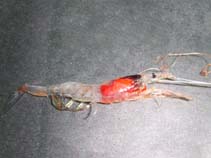Eusergestes arcticus (Kroyer, 1855)
Classification / Names Common names | Synonyms | CoL | ITIS | WoRMS
Malacostraca | Decapoda | Sergestidae
Environment: milieu / climate zone / depth range / distribution range Ecology
Bathypelagic; depth range 180 - 4500 m (Ref. 80197). Subtropical; 76°N - 60°S, 180°W - 180°E
Distribution Countries | FAO areas | Ecosystems | Occurrences | Introductions
Indo-Pacific, Atlantic, Mediterranean, Arctic and Antarctic: from Juan Fernandez (Chile), Chatham Islands, off New Zealand, south of Australia, and west to Amsterdam Island and Prince Edward Islands; Eastern Atlantic from Greenland, Iceland, Faeroe Islands, Norway, United Kingdom, Ireland, Spain, Morocco, into the Mediterranean, south to Gabon, Angola and South Africa, including Canary Islands; Western Atlantic from Greenland, Canada, USA to Uruguay, Argentina, Chile in the Magellan Strait and Falkland Islands. Polar to tropical.
Length at first maturity / Size / Weight / Age
Maturity: Lm ? range ? - ? cm Max length : 1.4 cm CL male/unsexed; (Ref. 80197)
Life cycle and mating behavior Maturity | Reproduction | Spawning | Eggs | Fecundity | Larvae
Main reference
References | Coordinator | Collaborators
Pérez Farfante, I. and B. Kensley 1997 Penaeoid and Sergestoid shrimps and prawns of the world: keys and diagnoses for the families and genera. Mémoires du Muséum National d'Histoire Naturelle 175:1-233. (Ref. 75620)
IUCN Red List Status
(Ref. 130435: Version 2025-1)
CITES status (Ref. 108899)
CMS (Ref. 116361)
Threat to humans
Human uses
| FishSource |
Tools
More information
Max. ages / sizes
Length-weight rel.
Length-length rel.
Length-frequencies
Mass conversion
Abundance
Internet sources
BHL | BOLD Systems | CISTI | DiscoverLife | FAO(Publication : search) | Fishipedia | GenBank (genome, nucleotide) | GloBI | Gomexsi | Google Books | Google Scholar | Google | PubMed | Tree of Life | Wikipedia (Go, Search) | Zoological Record



